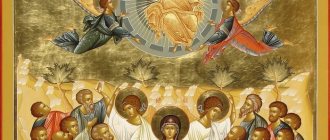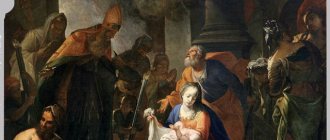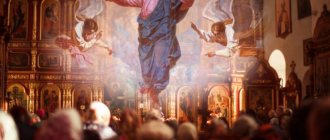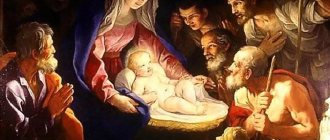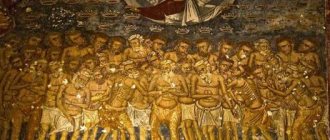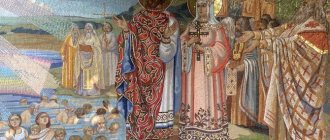The Ascension of the Lord is a moving twelve-day holiday, celebrated on the fortieth day after Easter, that is, it always occurs on Thursday of the sixth week after Easter. On this day, we remember how, after the resurrection, Jesus Christ led his disciples to the Mount of Olives and ascended into heaven, and also made a promise about His second coming. This holiday, established in the time of the apostles, is remembered daily by all Orthodox Christians by reading the Creed.
In honor of what event is celebrated on the Feast of the Ascension of the Lord?
Ascension of the Lord
The full name of the holiday is the Ascension of the Lord God and our Savior Jesus Christ .
The Feast of the Ascension of the Lord was established in memory of the event associated with the ascension of Jesus Christ on the 40th day after Easter.
The Ascension of the Lord is described in the Bible and is dedicated to the ascension (ascension) of Jesus Christ in the flesh into heaven and Jesus’ promise of his second coming.
The Feast of the Ascension of the Lord is interpreted as the deification of the human nature of Jesus, which after the Ascension became invisible to the bodily eye.
Is it exactly forty days?
Ascension of the Lord. Miniature of the Evangelary. Byzantium. XI century
What can be said specifically about Jesus' forty days with the disciples? Luke mentions forty days only once; in other places he either mentions an indefinite period of Jesus' stay or speaks of many days (Acts 13:31 ). The Evangelist Luke’s love for numbers is known (he gives numbers more than any other New Testament author), and he loves symbolic numbers. It is possible that to indicate the time of Jesus’ stay with his disciples, Luke could have taken forty as a symbolic number: in the Bible it meant the time of testing or God’s visit.
Perhaps Luke was starting from the holiday of Jewish Pentecost (in Hebrew - Shavuot, the day of the acquisition of the Torah, celebrated on the 50th day after the Jewish Passover - Ed.), the day on which a very important event for Luke’s narrative took place - the descent of the Spirit Saint. In this case, Luke would need to choose a day close to but preceding Pentecost. The symbolic number forty was a successful solution to this issue.
Perhaps, as already indicated above, Luke wants to make a parallel with this forty-day period to the story of Jesus’ forty-day fast. There Christ prepares Himself for service; here, during the same period, He prepares His disciples for the apostleship.
It is interesting that the Ancient Church did not celebrate the Ascension on the fortieth day after Easter, that is, it did not pay attention to the specific date indicated by Luke. Until the end of the 4th century, the Ascension was celebrated together with Pentecost. Around 383, the Roman pilgrim Egeria, who visited Jerusalem, reports on the celebration of the Ascension as follows: on the evening of Pentecost, all Christians in Jerusalem gather on Mount Olivet - “in the place (called Imvomon) from which the Lord ascended into heaven,” and a service begins with reading Gospels and Acts telling about the Ascension of the Lord.
But already from the beginning of the 5th century, this holiday was separated from Pentecost and coincided with the fortieth day, as it is celebrated to this day. Here, undoubtedly, it must be said that the testimony of the Evangelist Luke about the forty days separating the Resurrection from the Ascension turned out to be decisive for the date of the new holiday.
The history of the Feast of the Ascension of the Lord
Ascension of the Lord
The Ascension of the Lord is described in the book of Acts of the Holy Apostles.
At the direction of Jesus, on the 40th day after the Resurrection, the eleven apostles set out from Galilee to the Mount of Olives near Jerusalem.
There, on Mount Olivet, the apostles saw Christ in the flesh for the last time.
Jesus, raising His hands, gave them His blessing and began to move away from the disciples and ascend into heaven.
During the ascension, a bright cloud hid the Lord from the disciples and “two men in white clothes” appeared to the apostles, who promised the disciples that Jesus would come to Earth again in the same way as he ascended to heaven.
“He was lifted up before their eyes, and a cloud took Him out of their sight. And when they looked at the sky, during His ascension, suddenly two men in white clothes appeared to them and said: Men of Galilee! Why are you standing and looking at the sky? This Jesus, who has ascended from you into heaven, will come in the same way as you saw Him ascending into heaven.” (Acts 1:9-11)
The prediction of his Ascension was given by Jesus Christ to his apostles long before his death on the cross.
The Gospel of Luke tells of the meeting of the risen Jesus with his disciples and their conversation:
“Thus it is written, and thus it was necessary for Christ to suffer, to rise from the dead on the third day, and that repentance and forgiveness of sins should be preached in His name to all nations, beginning at Jerusalem. You are witnesses to this. And I will send the promise of my Father upon you; But stay in the city of Jerusalem until you are endowed with power from on high.” (Luke 24:46-49).
“And having gathered them together, He commanded them: Do not leave Jerusalem, but wait for the promise of the Father, which you have heard from Me, for John baptized with water, and a few days after this you will be baptized with the Holy Spirit. Therefore, they came together and asked Him, saying: Are you at this time, O Lord, restoring the kingdom to Israel? He said to them: It is not your business to know the times or seasons that the Father has appointed in His power, but you will receive power when the Holy Spirit comes on you; and you will be my witnesses in Jerusalem and in all Judea and Samaria, and even to the ends of the earth. Having said this, He rose up before their eyes, and a cloud took Him out of their sight.” (Acts 1:4–9).
This is how Evangelist Matthew describes this event:
“...the eleven disciples went to Galilee, to the mountain where Jesus commanded, and when they saw Him, they worshiped Him, but others doubted. And Jesus drew near and said, “All authority in heaven and on earth has been given to me.” Go therefore and make disciples of all nations, baptizing them in the name of the Father and of the Son and of the Holy Spirit, teaching them to observe all that I have commanded you; and lo, I am with you always, even to the end of the age.” (Matt. 28:16–20).
Luke writes:
“... He led them out of the city as far as Bethany and, lifting up His hands, blessed them. And when he blessed them, he began to move away from them and ascend to heaven. They worshiped Him and returned to Jerusalem with great joy.” (Luke 24:50–53).
Where is Jesus now?
Lord Almighty.
Ascension of the Lord; Italy. Venice. St. Mark's Cathedral; XII c The fact that Jesus Christ, after His Resurrection, ascended into the mystery of God, to the Heavenly Father, is a fundamental point of the Christian faith, which runs like a red thread through the New Testament writings. Only the Apostle Luke constructs a detailed and colorful account of this event, while other authors talk about it more secretly. But they say.
Let's start with the fact that in general the most quoted Old Testament text in the New Testament is the words of Psalm 109: The Lord said to my Lord: sit at the right hand (that is, on the right hand, which in the Hebrew tradition symbolizes closeness and trust. - Note by Archpriest K . Parkhomenko) Me, until I make Your enemies Your footstool (Ps 109:1).
These words, which, by the way, are included in our Creed, are found in the New Testament almost two dozen times. The idea of glorifying Jesus next to God the Father is recorded in the most ancient pre-Paulian tradition. Here are the texts that the Apostle Paul accepted in an already compiled form: He (Jesus) made Himself of no reputation, taking on the form of a servant, becoming in the likeness of men, and becoming in appearance like a man; He humbled Himself, becoming obedient even to the point of death, even death on the cross. Therefore God has highly exalted Him and given Him the name that is above every name, so that at the name of Jesus every knee should bow, in heaven and on earth and under the earth, and every tongue confess that Jesus Christ is Lord, to the glory of God the Father (Phil. 2:7–11).
God appeared in the flesh, justified Himself in the Spirit, showed Himself to angels, preached to the nations, was accepted into the world by faith, ascended in glory (1 Tim. 3:16).
The very first New Testament author, the Apostle Paul, does not write directly about the Ascension of Christ, but he reports a lot about the return of Jesus from the world of God. For example, in his earliest letter, Paul says that the Thessalonians are waiting from heaven for His Son, whom He raised from the dead, Jesus... (1 Thessalonians 1:10 ; cf. 4:16 ).
And in the evangelical tradition (in the evangelists Mark, Matthew and Luke) we find numerous statements about the return of Christ (Matthew 16:27 ; 24:30 ; 26:64 ; Mark 8:38 ; 13:26 ; Luke 21:27 ; 22 : 69). But one can only assume a return in relation to someone who has gone somewhere.
So, we can say with confidence that the New Testament affirms that the Risen One is now with the Heavenly Father in another world, or, to use the language of ancient metaphors, the Son is now in Heaven.
How is the service held in Orthodoxy on the day of the Ascension of the Lord?
Ascension of the Lord
The Feast of the Ascension of the Lord is one of the Twelve Holidays.
The service in honor of the Ascension of the Lord is performed according to the Colored Triodion.
On the eve of the festive Thursday, on Wednesday evening, an all-night vigil is served, at vespers of which stichera dedicated to the Ascension of the Lord are sung. At the same time, three proverbs are read, which, according to the Orthodox Church, contain Old Testament prophecies about the Ascension of Jesus Christ.
At Matins the Gospel of Mark and two canons are read. They were compiled by Saints John of Damascus (8th century) and Joseph the Songsinger (9th century). According to legend, the kontakion and ikos for the holiday were composed by the Venerable Roman the Sweet Singer (5th century).
At the liturgy, festive antiphons are sung, the Apostle's first conception (Acts 1:1-12) and the Gospel of Luke, 114 conception (Luke 24:36-53) are read.
The texts of church hymns describe the ascent of Jesus to heaven and His meeting with the angels, and also tell the symbolic meaning of the event of the Feast of the Ascension of the Lord.
Lord, the sacrament that has been hidden from time immemorial and from generation to generation, having fulfilled itself as Good, came with your disciples to the Mount of Olives, having given birth to You, the Creator of all and Maker. Even though during Your Passion you felt more maternal pain than all others, it is fitting for Your flesh to enjoy much joy. Even as we have received communion, even as Thy Lord rises into heaven, we glorify Thy great mercy upon us.
Behold, the day of the Lord is coming, and on that day they will stand before Him on the Mount of Olives, right in Jerusalem, towards the east of the sun.
Summary
Apostles. Fragment of the fresco of the Ascension of the Lord. XIV century
So, in our short essay we looked at various aspects related to the event of the Ascension of Jesus Christ. Let's summarize and remember what we talked about.
After the Resurrection, Jesus Christ stays with the disciples in our world for some time. None of the authors of the New Testament, except the Apostle Luke, records the duration of this time.
Then the appearances of the Risen One stop, which allows us to talk about Christ’s departure from his disciples. Where? To Heaven, to God.
Evangelist Luke explains the mystery of the Risen One’s stay with the disciples and at the same time emphasizes the greatness of the event of leaving for Heaven: he says that Christ stays with the Apostles for a symbolic amount of time - forty days.
What happened to the Risen Jesus after the period of His appearances is explained by the New Testament authors using biblical figurative expressions. The key here is the Old Testament text: The Lord said to my Lord: Sit at My right hand, until I make Your enemies Your footstool (Ps. 109:1).
The New Testament writers avoid naturalism in describing Jesus' departure to Heaven. (We must remember that heaven is also a conditional indication of the place of the Lord. In the time of Christ, no one believed that God was in the sky, which is above our heads. The biblical “heaven” (Hebrew shamayim) was a symbolic place of residence Therefore, when Christ commands to pray “Our Father who art in heaven...”, He means the spiritual heaven rather than anything related to our cosmos.
Evangelist Luke does not hesitate to openly and straightforwardly write about Christ’s departure to God the Father as a flight, movement in space. He may be doing this in reference to the numerous texts (Greco-Roman and Jewish) that reported similar stories. Perhaps Luke wanted to show his readers that Jesus was glorified like other great ancient heroes, perhaps simply using traditional expressions and images that were understandable to readers of his time and culture.
We do not know how much the story of the Evangelist Luke corresponds to historical reality. The caution in the description of this event by other New Testament authors suggests that the Ascension event was a secret event, and not public. But whether everything happened exactly as Luke describes or not is not so important. It is important that Luke, having given us a magnificent and expressive story about the Ascension, contained an abyss of theological meanings, which many generations of Christians will have to discover and draw spiritual treasures from.
First, in the Gospel with a large brush, and then, in the book of Acts, with a small brush, Luke paints an icon of Jesus’ departure from our world to Heaven. Here the angels are witnesses to the event (there are two of them, because according to Jewish ideas only the testimony of two matters); here is a cloud (symbol of the shekinah - the Glory of God); the joy of the disciples, because their Teacher is now the Heavenly King glorified by God.
The Ascension of Christ, according to the thoughts of subsequent generations of Christians, is a unique event: the glorification of the human body that the Risen Jesus Christ had, a prerequisite for the gift of the Holy Spirit to believers and, thanks to the heavenly accession, the spread of Christ’s power over the entire Universe.
|
Icons of the Ascension of the Lord
Ascension of the Lord
Icons depicting the Ascension of the Lord have a clear iconography.
These icons depicting the Ascension of the Lord should depict all twelve apostles and the Mother of God standing between them.
The disciples of Christ in the icon are depicted either simply standing or standing on their knees.
Christ is depicted ascending in a cloud, surrounded by angels.
Iconography
| Ascension of the Lord. Relief on the door of the Basilica of Santa Sabina, 5th century |
The earliest image of the Ascension of the Lord that has come down to us is a relief on the wooden doors (c. 430) of the Church of Santa Sabina in Rome: a standing Christ with a scroll in his hand is surrounded by symbols of the Evangelists in medallions, on the sides of the figure are the letters A and Ω, below is the Virgin Mary, above Ney 2 apostles hold a cross in a circle.
This image of the Virgin Mary is traditionally interpreted as a symbolic image of the Church [15]; a similar interpretation is preserved in relation to the monuments of the Middle Ages. Description of the Ascension in the Holy. Scripture and the depiction of this event in Christ. The iconographies differ in one important feature, indicating that the iconography is based on a liturgical tradition glorifying the triumphal ascension of the flesh of Christ into heaven. On the relief and on all subsequent images, the Virgin Mary is represented in the center of the composition; Church Tradition testifies to Her presence at the Ascension of the Lord: the works of St. Fathers, texts of the Ascension Feast service. The ampulla of Monza [16] presents a fully developed composition: a mandorla with the ascending Christ, who sits on a throne, supported by 4 angels, below is the Virgin of Oranta and 12 animatedly gesturing apostles. In the miniature of the Gospel of Rabbala [17], Christ stands in a halo with a scroll in his hand, and below him is the chariot of the prophet. Ezekiel (tetramorph and wheels), 2 angels support the halo, 2 others bring victory wreaths, below, in the center, is the Mother of God, on the sides are angels and apostles, including the apostle. Pavel with a book in his hands.
| Ascension of the Lord. Miniature from the Gospel of Rabbi. 586 (Larent. Plut. I 56. Fol. 13v) |
In the miniatures of the Psalter, the Ascension of the Lord illustrates several psalms.
Thus, in the Khludov Psalter [18] in the miniature to Ps 23:9-10 (“Take up your gates, O princes,” l. 22) Christ stands in radiance, the mandorla is carried by 2 angels, and doors are in the heavenly segment; on the other, to Ps 46:7 (“God Arose with a Shout,” fol. 46 vol.), Christ sits on a rainbow. The last type of image has become the most common. In temple paintings, the Ascension of the Lord is placed in the dome [19] or on the vaults [20]. In the 12th century in the composition the number of angels who carry a halo with the ascending Christ has increased [21].
In the church of the martyr. George in Kurbinovo (Macedonia), 1191, the mandorla of Christ depicts fantastic cloud figures of animals and fish. Scene of the Ascension in a miniature from the Words of Jacob Kokkinovathsky, 12th century. [22], is presented in the interior of a 5-domed temple, in the lunette of which is “The Descent of the Holy Spirit”, in the side spaces - the prophets Isaiah and David with unfolded scrolls. On the icons in. The Mother of God, standing frontally, is usually represented not with raised arms, but with an open palm in front of her chest [23].
The description found among Russian pilgrims (“The Walk of Abbot Daniel,” early 12th century) of a stone with, according to legend, the imprints of the Savior’s feet left on it influenced the composition of the iconography of the Ascension of the Lord in Pskov icons of the 16th century, where this stone is depicted on the mountain , under the mandorla of the ascending Savior (for example, icon 1542, PIAM).
The meaning of the Feast of the Ascension of the Lord
The main result for humanity of the Ascension of Jesus was that from that moment human nature received full participation in the Divine life and eternal bliss.
The vision of the first martyr Stephen of Jesus standing at the right hand of God as the Son of Man (Acts 7:55-56) suggests that the human nature of Christ was not dissolved or absorbed by the Divine.
God the Father, having taken upon himself human flesh, just as the Lord Jesus did not escape death, but conquered it and made human nature equal in honor and co-throne with the Divinity, according to which he remains the God-man forever and will come to earth the second time “in the same way” as he ascended to heaven (cf. Acts 1:11), but already “with power and great glory” (Matthew 24:30; Luke 21:27).
Where has the Risen One moved?
Although the New Testament clearly speaks of the presence of the Risen Christ with the Father, in the glory of God, or on the Throne of God, the New Testament authors avoid saying that Jesus got there thanks to flight, that is, some kind of physical movement to Heaven.
One group of texts speaks simply of the exalted position of Christ. Another speaks of Christ's transfer to Heaven, but does not explain how this happens. Some texts mention the word Ascension or its equivalent (Rom 10 :6–8; Eph 4 :7–11), while others omit the technical terms (Heb 4:14 ; 6 :19–20; 1 Pet 3:22 ).
The Evangelist John writes a lot about this. For him, Jesus is the One who descends from Heaven and subsequently returns there. Three times John speaks of the ascension of the Son (John 3:13; 6:62; 20:17), but usually uses the term “journey” (Greek poreuomai), “departure” (Greek hypago), or “exaltation” (Greek hypsoo).
What can and should be done on the Feast of the Ascension of the Lord
- it is better to spend this day in the home family circle and in prayer;
- on Ascension Day, it is recommended to maintain peace and tranquility in your soul and not quarrel with friends and loved ones;
- on this day it is advised to remember deceased relatives and restore a spiritual connection with them;
- you can go to visit relatives and friends; in the old days this was called “going to a crossroads”;
- on the eve of the Ascension of the Lord, it is customary to bake special pancakes “for Christ’s path”, they are also called “God’s Envelopment”, “Onuchki”, “Christ’s Shoes”.
Signs, conspiracies, rituals
Signs are most often associated with the harvest. Description will accept:
- If it rains on this holiday, do not expect a good harvest.
- Heavy rain, and even with a thunderstorm, means a cold summer.
- If there is a light “blind” rain, it means mushroom autumn.
- A beautiful rainbow is a favorable sign that promises well-being and prosperity to all Orthodox Christians.
- If it's dry that day, it won't rain for another six weeks.
- With wet weather, the next six weeks will be rainy.
- If there is precipitation, Ilya will experience a severe thunderstorm.
- A wish made on Ascension will certainly come true.
- It is not recommended to clean the house, otherwise you can sweep away happiness and good luck.
- If a chicken lays an egg, then it will protect the house from troubles and misfortunes.
Many signs are associated with the marriage of girls : a few days before the Ascension, girls chose young birch trees in the forest and curled several branches on them into a braid. The girl whose branches have not unraveled will certainly get married this year.
Women washed themselves with morning dew to stay young longer.
There are spells for good luck, career growth, and also for the growth of everything planted in the garden. To get a good harvest, when you go to the garden, grab a birch twig, tie it with bright ribbons, then stick it in the middle of the garden with the words:
“As a birch tree grows, so you, my crops, grow, fill with juice, know life-giving water and the sun. Exactly!"
To prevent your back from bothering you while working in the garden, touch the ground, and then say the spell three times:
“As light as Mother Earth is, as high as her strength is, so it will be easy for me with her, my body will drink in her strength. Let it be so!"
Literature
- Macarius. Orthodox dogmatic theology. T. 2. P. 176-177;
- Benoit P. L'Ascension // RB. 1949. Vol. 56. P. 161-203;
- Davies JG He Ascended into Heaven: A Study in the History of Doctrine. L., 1958;
- Lohfink G. Die Himmelfahrt Jesu: Untersuch. zu den Himmelfahrts- und Erhöhungstexten bei Lukas. Münch., 1971. (StANT; 26);
- Alsup JE The Post-Resurrection Appearance Stories of the Gospel Tradition. Stuttg., 1975;
- Harris MJ Raised Immortal: Ressurection and Immortality in the NT. Grand Rapids, 1983;
- Kasper W. Christi Himmelfahrt: Geschichte und theologische Bedeutung // Communio: Intern. Katol. Zschr. 1983. Bd. 12. S. 205-213;
- Fitzmyer JA The Ascension of Christ and Pentecost // Theol. Studies. Baltimore, 1984. Vol. 45. P. 409-440;
- Parsons MC The Departure of Jesus in Luke-Acts. Sheffield, 1987. (JSOT. Sup.; 21);
- Farrow D. Ascension and Ecclesia: On the Significance of the Doctrine of the Ascension for Ecclesiology and Christian Cosmology. Edinb., 1999;
- Hierotheus (Vlachos), Metropolitan. Lord's holidays / Transl. from modern Greek D. Gotsalyuk. Simferopol, 2001. pp. 321-355
- Schmid AA Himmelfahrt Christi // LCI. Bd. 2. Col. 268-276.
